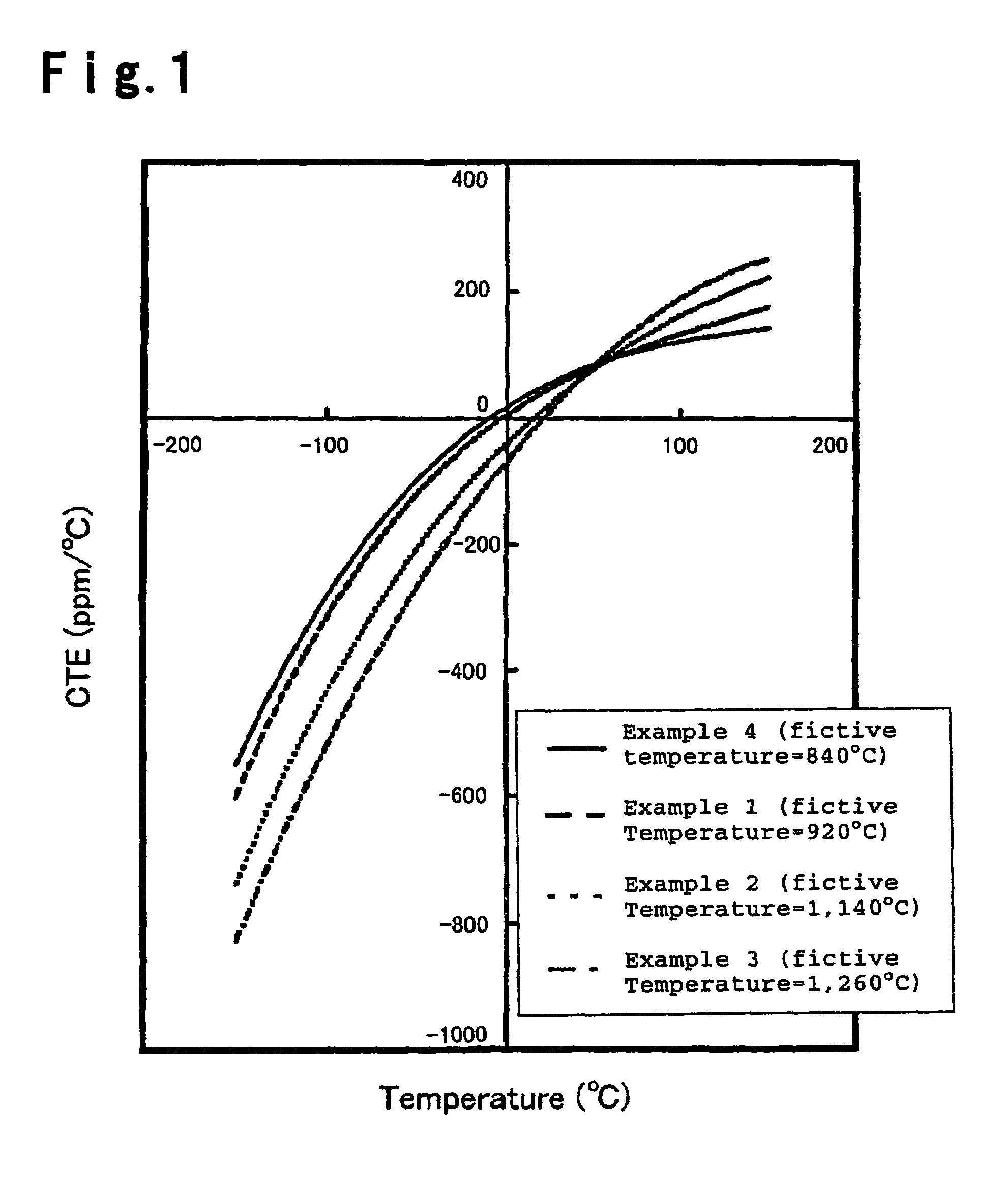Silica glass containing TiO2 and process for its production
a technology of silicon glass and tio2 is applied in the field of silicon glass containing tio2, which can solve the problems of substantially zero coefficient of thermal expansion, limited to about room temperature, and temperature region where the coefficient of thermal expansion becomes substantially zero, and achieves excellent uniform mechanical characteristics and coefficients
- Summary
- Abstract
- Description
- Claims
- Application Information
AI Technical Summary
Benefits of technology
Problems solved by technology
Method used
Image
Examples
example 1
[0055]TiO2—SiO2 glass particles obtained by gasifying TiCl4 and SiCl4 as glass-forming materials for TiO2—SiO2 glass, respectively, then mixing them and feeding them to heat hydrolysis (flame hydrolysis) in oxyhydrogen flame, were deposited and grown on a target to form a porous TiO2—SiO2 glass body having a diameter of 8 cm and a length of 12 cm (step (a)).
[0056]The obtained porous TiO2—SiO2 glass body was heated to 1,550° C. in an atmosphere of 100% He and held at this temperature for 10 hours for vitrification to obtain a vitrified TiO2—SiO2 glass body (step (b))
[0057]The obtained vitrified TiO2—SiO2 glass body was heated to 1,600° C. i.e. higher than the softening point for deadweight transformation and formed into a block shape having a predetermined size to obtain a formed TiO2—SiO2 glass body (step (c))
[0058]The obtained formed TiO2—SiO2 glass body was set in an electric furnace and held at 950° C. for 100 hours. Then, the temperature was lowered to 500° C. at a rate of 5° C....
example 2
[0059]In the step (d) in Example 1, the cooling conditions after slicing were changed, and the formed TiO2—SiO2 glass body was set in an electric furnace and held at 1,200° C. for 20 hours. Then, the temperature was lowered to 500° C. at a rate of 5° C. / hr, and then, the glass body was cooled to room temperature. Other than this, in the same manner as in Example 1, TiO2—SiO2 glass was obtained.
example 3
[0060]In the step (d) in Example 1, the cooling conditions after slicing were changed, and the formed TiO2—SiO2 glass body was set in an electric furnace and held at 1,300° C. for 2 hours. Then, the temperature was lowered to500° C. at a rate of 5° C. / hr, and then, the glass body was cooled to room temperature. Other than this, in the same manner as in Example 1, TiO2—SiO2 glass was obtained.
PUM
| Property | Measurement | Unit |
|---|---|---|
| fictive temperature | aaaaa | aaaaa |
| fictive temperature | aaaaa | aaaaa |
| fictive temperature | aaaaa | aaaaa |
Abstract
Description
Claims
Application Information
 Login to View More
Login to View More - R&D
- Intellectual Property
- Life Sciences
- Materials
- Tech Scout
- Unparalleled Data Quality
- Higher Quality Content
- 60% Fewer Hallucinations
Browse by: Latest US Patents, China's latest patents, Technical Efficacy Thesaurus, Application Domain, Technology Topic, Popular Technical Reports.
© 2025 PatSnap. All rights reserved.Legal|Privacy policy|Modern Slavery Act Transparency Statement|Sitemap|About US| Contact US: help@patsnap.com

